Reading to the Endgame
A novel approach to computer chess
D. Graham Burnett and W. J. Walter
Stimulated by Levi’s juxtaposition, and motivated by the possibilities of extending an Oulipian sensibility into the sphere of literary criticism (OuCriPo?), the authors set out to develop a means by which a given novel could express itself as a game of chess. Initial success here led to expanded ambition, since there was nothing to stop us from elaborating our modest analytic protocol into a full-fledged “engine” that would permit works of literature to confront one another on the chess board. We have advanced this project to what we think of as a workable tool for a certain sort of ludic literary investigation, and we present it here for the first time, together with some preliminary results drawn from several thousand games we have run to date. The current version of the program is playable on the Cabinet website [see end of article—Eds.], and we would be delighted if it proved useful to those wishing to pursue this or related lines of inquiry.
We now have everything in place to convert two texts into a game of chess: we simply feed the program the two novels, asking it to play one text as “white” and the other as “black”; the program searches through the white text until it finds the first tuple corresponding to a movable piece (in the case of an opening move, either a pawn or a knight), and then, having settled on the piece that will open, continues searching through the text until it encounters a tuple designating a square to which that piece can be moved. When it has done so, the computer executes that move for white, and then goes to the other text to find, in the same way, an opening move for black. And so it goes: white, black, white, black, until—quite by accident, of course, since we must suppose that the novels know nothing of chess strategy (and our program cannot help them, since it knows only the rules of the game)—one king is mated.
Such a set up would be close (there turn out to be interesting differences, but put that aside for now) to permitting two monkeys to play chess against each other by giving each a keyboard and permitting them to jump about on them: send the resulting string of letters to our program, and it scans this string of gobbledygook for tuples that constitute legitimate moves, makes them, and voilà, monkey chess.
We experimented with something along these lines (no monkeys, as it happens, but a similar sort of stochasticity) before setting to work building into the basic application a greater sensitivity to the specific qualities of the string of characters upon which it was set to work. Our aim was to produce an algorithm that could, in some modest way, “read” literary works for their distinctive “voice” or “style” and then convert that linguistic particularity into something approaching a style of play.
It is the premise of stylometry that writers necessarily, albeit unintentionally, imprint their texts with distinctive statistical signatures, which can be identified by means of close attention to sentence length, word and letter frequency, and other quantitative attributes of their prose. Thus a chess program sensitive to the stylometric parameters of a given text should in principle afford a mechanism for translating authorial voice into a way of playing the game.
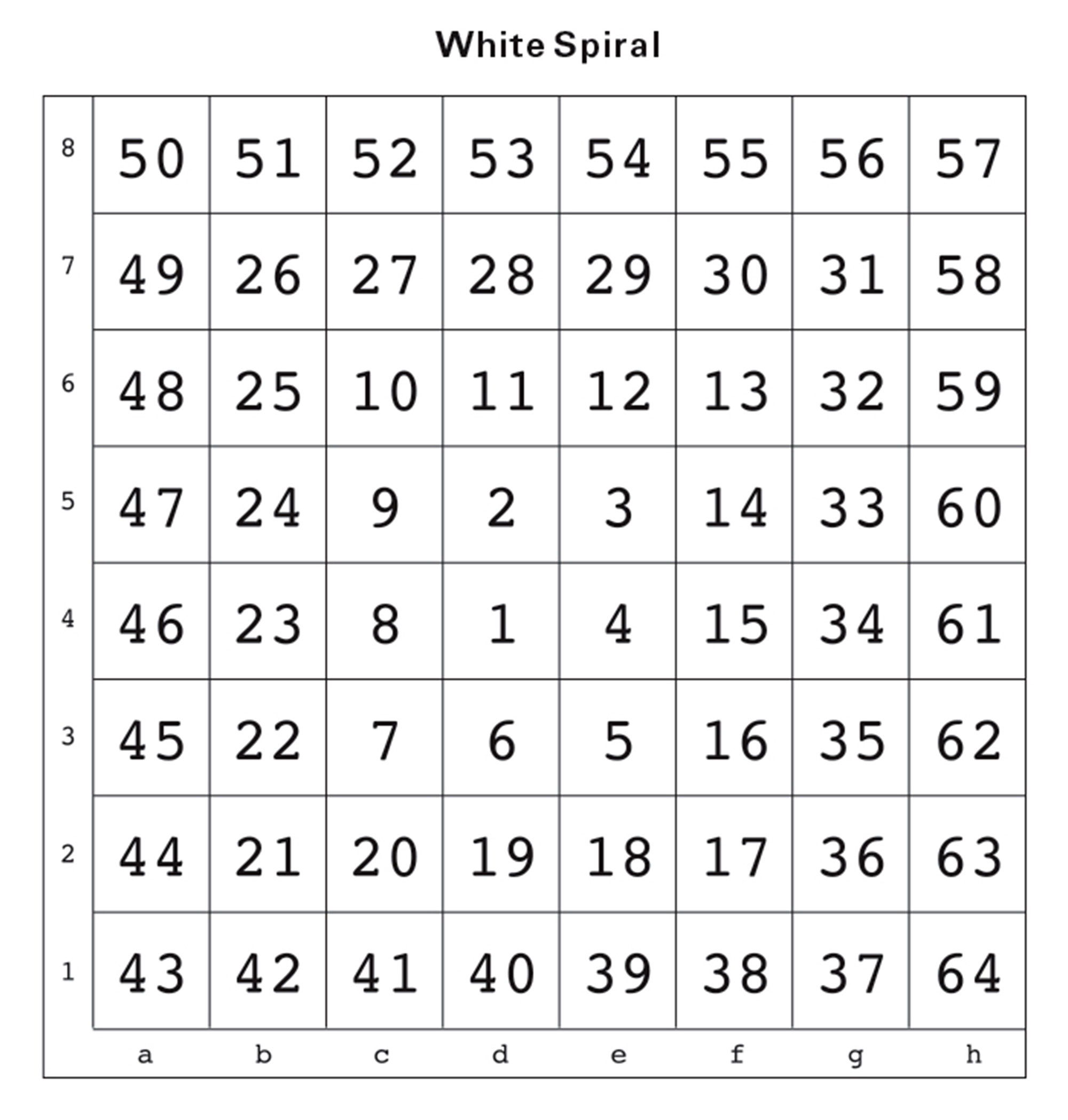
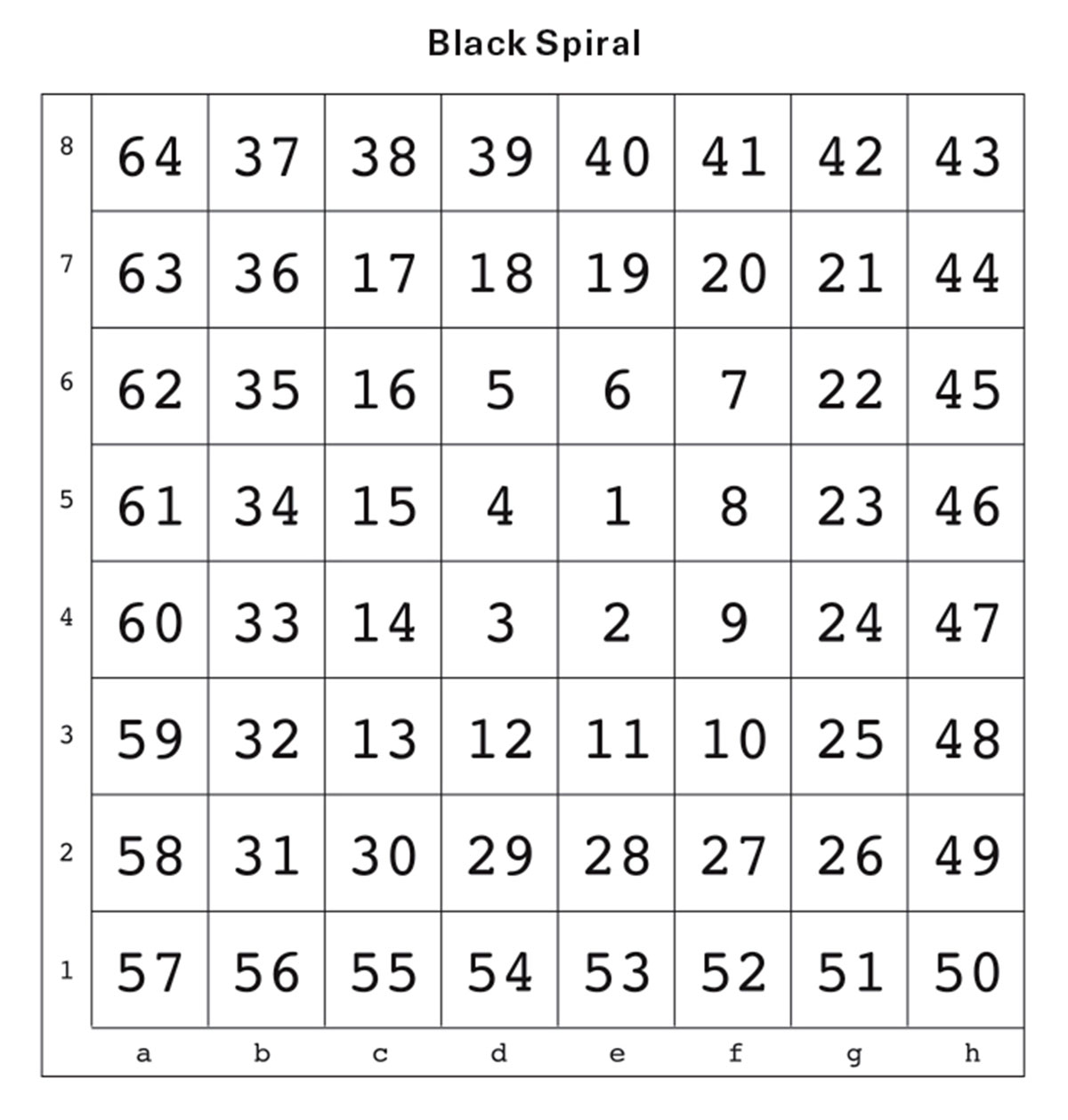
The tuples of highest frequency (in Verne’s novel, es, en, le, on; in the Austen, he, th, er, in) thus control the strategic center of the board. Instead of the old, arbitrary tuple coordinates based on a–h and i–p, the squares on the board are now “called” by tuples that have a patterned and systematic relationship with the work in question. And note that these positions are assigned separately for each novel, so each text will play on a coordinate field determined by its own linguistic parameters.
We are now ready to begin play, with the program seeking an opening move for white by scanning, as already outlined, first for a tuple corresponding to a movable piece, and then, having made that determination, for a subsequent tuple corresponding to a legitimate move. In this case, white finds the unconventional-but-storied “Grob attack” or “Spike opening” in its very title (after a heady debate we decided to treat the title and author, though not the publisher or place of publication, as “part” of the analyzable text): the “au” of Voyage au Centre having been assigned in this case to g2, and thus to white’s g-pawn; and the “tr” of Centre designating, again on the basis of the initial tuple frequency analysis, the board position g4. Black, seemingly wobbled by this irregular attack, answers with a hesitant Rook-pawn to h6, on the basis of the “li” in Sensibility and the “fo” in the telling opening phrase “for many generations.” The contest is joined.
It plays out as depicted below, with white uncorking a fatal King-pawn to d4 on the basis of the palindromic tuples “se” and “es” as they appear in the following sentence:
Mais de faire entendre raison au plus irascible des professeurs, c’est ce que mon caractère un peu indécis ne me permettait pas. (But to make the most irascible of professors hear reason, this my somewhat hesitant character did not allow.)
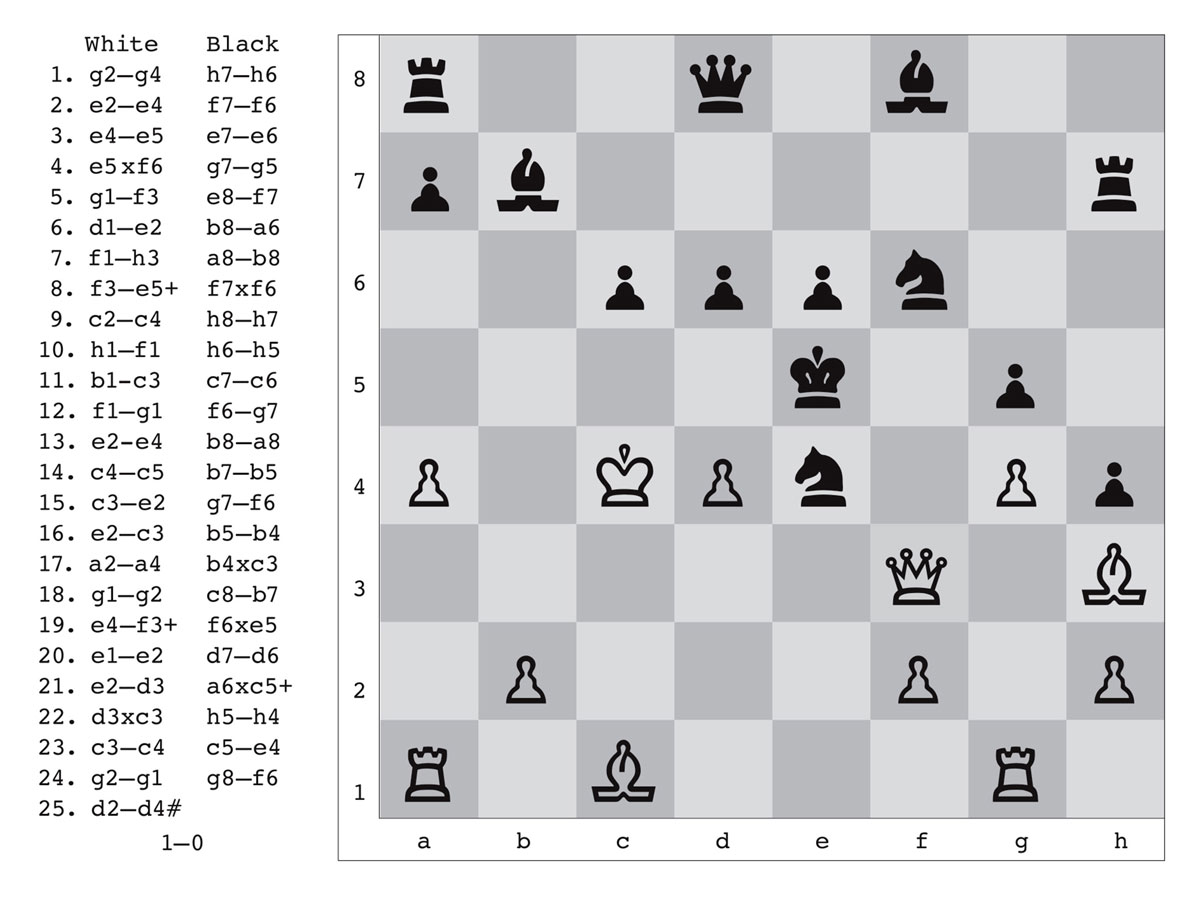
For starters, a relatively brief, “tight” game like Voyage au Centre de la Terre vs. Sense and Sensibility is more the exception than the rule: overall about 30% of our games end in checkmate, and the rest wind up as draws (of which a little less than 30% are stalemates).[2] Of the games that end with a victor, the average number of moves to mate is seventy-one, and in many of these pawn-promotion plays a significant role (pawns reaching the opponent’s home row can be “promoted” to Queen, and several “Queens” of the same color can thus occupy the board at the same time).[3] Our longest contest to date is the marathon showdown between Herman Melville’s tricky The Confidence-Man (1857) and the novel often accorded foundational status in the history of el realismo in Spain, La Gaviota (The Seagull, 1849), authored by the cosmopolitan aristocrat Cecelia Böhl von Faber (writing under the pseudonym Fernán Caballero). This tête-à-tête sees von Faber’s celebrated naturalismo grind Melville’s Manichean insouciance to the humiliating configuration shown here after no fewer than 159 moves.
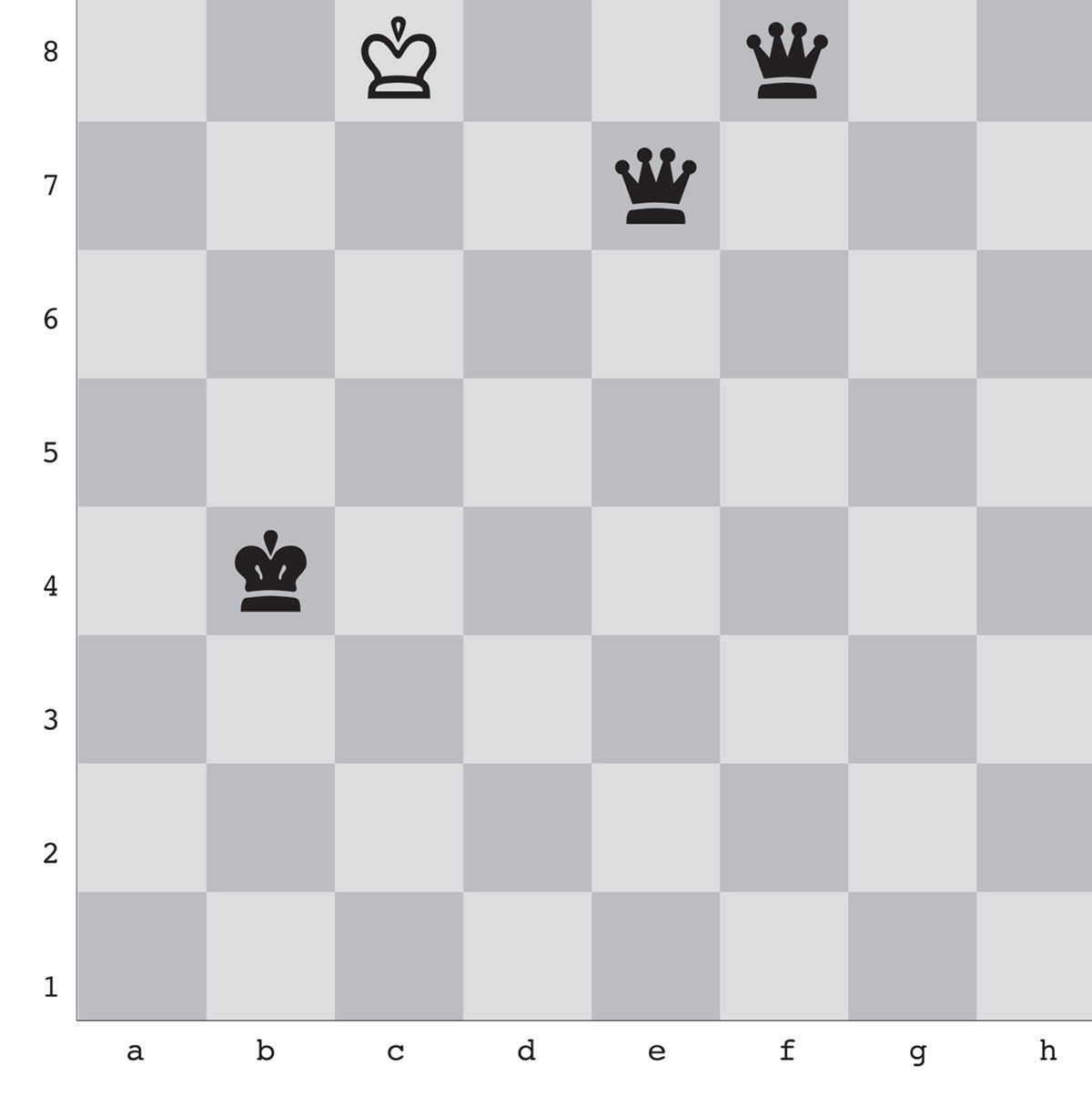
Nearly as exhausting is the 141-move slugfest between Benjamin Constant’s lapidary tale of ennui and seduction, Adolphe (1816), and La Bodega (1905), Vincente Blasco Ibáñez’s crusading proto-prohibitionist indictment of wine-drenched backwardness in Andalucía—a game that culminates in yet another triumph for Iberian social realism. These contests stand in marked contrast to the Teutonic lightning-strike by which Theodor Fontane’s Effi Briest (1894)—a favorite of Thomas Mann’s—undoes Rafael Delgado’s slightly over-ripe late exercise in Mexican sentimentality, Angelina (1947): an eleven-move frontal Blitzkrieg that ends as follows:
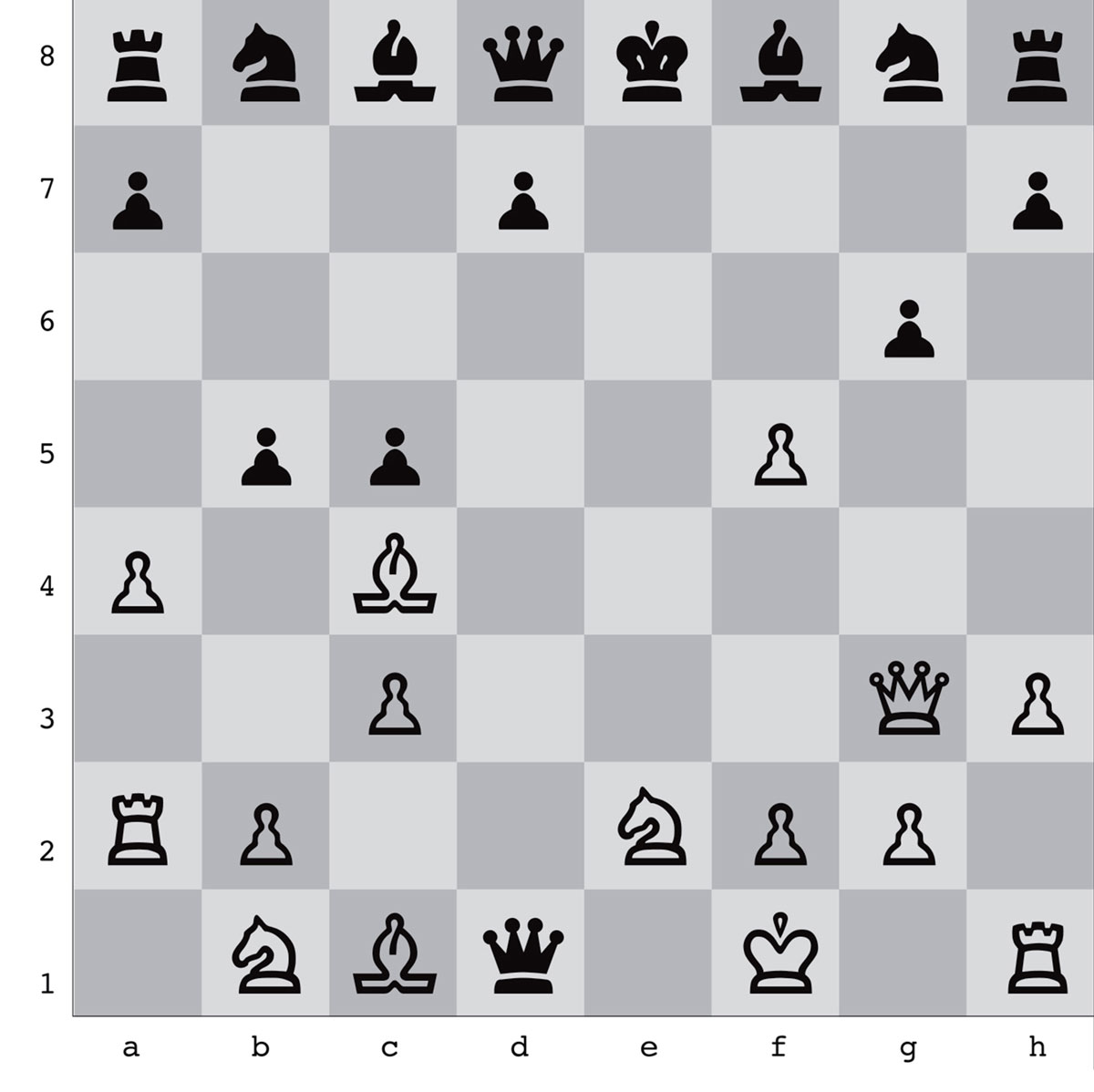
We were prepared to believe, reviewing the transcripts of many considerably more meandering games, that what we were looking at was really—in the end, putting aside the vague charm of thinking of the opponents as works of literature—indistinguishable from the sort of aleatory “monkey chess” alluded to above. But a control seems to prove otherwise: we built a small test module of our program that did indeed choose moves for black and white on a random basis, and discovered to our surprise that this device posted a significantly higher rate of checkmate games than actual novel chess (slightly over 40%). We have an intuition as to why this should be so, but it is tentative, and we reserve it at present, welcoming in the meantime suggestions from those interested in taking the question up.
Other peculiarities remain. In something akin to match play, we find French novels in general, and Adolphe in particular, to be the toughest competition. This would doubtless delight François Le Lionnais, the chemical engineer who initiated the Oulipo group and authored half a dozen books of chess problems, but we are at present without an explanation as to why it should be so. In our last “world cup,” a five-novel French team (led by Alexandre Dumas) trounced the competition, defeating the second-place English team by a 20% margin (the UK was hurt by poor performance from Disraeli’s The Infernal Marriage of 1834), and leaving the also-ran Italians looking rather like novices. Sample sizes for this tournament were not enormous (on the order of 900 games, resulting in some 300 checkmates), and we are continuing to explore just how statistically robust this apparent anomaly actually is. We are inclined to think that differences in “national styles”—if firmly established—will be explained by reference to the striking, and seemingly consistent, divergence of tuple frequencies across different language groups, divergences particularly pronounced at the high end of the frequency range. Grossly speaking, the four most common tuples in a given French text tend to be relatively close in their overall rate of appearance. By contrast German, for instance, sees a sharper decrease in frequency across this same range (interestingly, English, which on average falls somewhere in-between, shows a much higher degree of variability in this metric). How exactly these sorts of statistical characteristics affect game performance under our algorithm we cannot yet say.
As to why Constant’s thinly veiled exposé of the intricate erotic politics surrounding Madame de Staël should prove so formidable an adversary, that is a perfect mystery (though it should be noted that both Frankenstein, in the second edition of 1831, and Goethe’s epochal 1774 Die Leiden des Jungen Werther, playing black, successfully fight off forceful opening gambits and record victories against this opponent). For those who remember without fondness the distinctively suffocating adolescent solipsism of Adolphe, there is a perverse satisfaction to be had watching Adolphe (playing black) fall to Adolphe (playing white) in fifty-nine shambolic moves that involve much fruitless horseplay. An appetite for such forms of poetic justice is not, however, consistently sated by our software, as one certainly does not expect Huckleberry Finn (1884, playing white) to be picked apart in passive resignation by Kafka’s Die Verwandlung (The Metamorphosis, 1915), and it is difficult to look on with suitably clinical detachment. In particular, a too-little, too-late counterpunch of (promoted) Queen b8-e5 must be said to painfully darken the miasma of futility that hangs over this confrontation from the first move (Huck’s defensive “Anderssen” opening, the paralytic a2-a3).
In closing, it is perhaps worth addressing the possibility of composing novels specifically calibrated to win chess tournaments convened by our application. The prospect of a “grand-master,” a kind of all-purpose novel-killing novel, while alluring, strikes us as beyond reach—indeed as probably a formal impossibility. But a novel written to defeat some other specific novel would appear to be an attainable objective, though a little thought suggests this would be by no means a trivial undertaking. While “encoding” tuples that would defeat a given opponent would in principle be quite easy, the real problem is doing so in the context of a work that must generate, on the basis of stylometric analysis of overall tuple frequencies, the very coordinate plane upon which those moves will be made. This would seem to give the problem a recursive character of some complexity.[4] More work is needed.
Try your hand at Novel Chess here. Note that an updated version that allows you to upload your own text is available here.
The US Chess Federation wrote an article on Novel Chess; to read the article, go here.
Isadora McCarthy’s 2023 experiment with pitting Kurt Schwitters’s Ursonate against Proust’s Du côté de chez Swann is here.
- For an overview of the state of the field in this formative period, see Anthony Kenny, The Computation of Style (Oxford: Pergamon Press, 1982). For a brief history of the development of the analytic techniques themselves, consider: David I. Holmes, “The Evolution of Stylometry in Humanities Scholarship,” Literary and Linguistic Computing, vol. 13, no. 3 (1998), pp. 111–117.
- Our program treats both three repetitions of the same board position and fifty moves without capture or pawn move as “automatic” draws; this is a slight tweak of chess rules, which require in each case that the draw be formally claimed by a player.
- Serious chess players will want it noted that a pawn reaching the opponent’s home row may be promoted to any board piece (except a King) and may not remain a pawn. In practice, our program promotes only to Queen. In human play, promotions to other pieces are very rare.
- A saving grace here may lie in the fact that many of our games play out without making use of more than a small fraction of one or both of the novels at issue. This would seem to open the way to drafting a novel, analyzing its tuple frequency, building the board coordinates (using the spiral configuration outlined above), and then “editing” the opening chapter to plot the moves necessary to defeat a given opponent, but doing so while maintaining tuple-frequency neutrality (probably by off-sets elsewhere in the text).
D. Graham Burnett is an editor at Cabinet (at whose event space he co-hosts the monthly Poetry Lab) and a member of the faculty at Princeton University (at which he teaches history of science). He is the author of several books, including Descartes and the Hyperbolic Quest (American Philosophical Society, 2005), A Trial By Jury (Knopf, 2001), and Masters of All They Surveyed (Chicago, 2000).
W. J. Walter lives in Paris.
Spotted an error? Email us at corrections at cabinetmagazine dot org.
If you’ve enjoyed the free articles that we offer on our site, please consider subscribing to our nonprofit magazine. You get twelve online issues and unlimited access to all our archives.